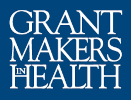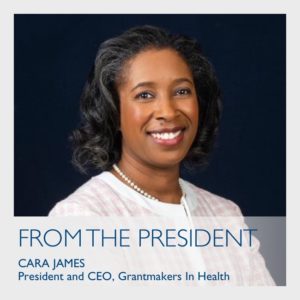Cara V. James, PhD, President and CEO, Grantmakers In Health
The events of the past few months have led many foundations, corporations, and others to make or renew commitments that support health equity, racial justice, better relationships between communities and the police, and organizations led by communities of color. Foundations such as the Ford Foundation, John D. and Catherine T. MacArthur Foundation, W.K. Kellogg Foundation, Andrew W. Mellon Foundation, and Doris Duke Charitable Foundation announced plans to substantially increase their spending. The Robert Wood Johnson Foundation and Missouri Foundation for Health have contributed to the St. Louis Regional Racial Healing Fund, started by the Deaconess Foundation to challenge the conditions that reinforce systemic racism. The Rockefeller Foundation created the Rockefeller Foundation Opportunity Collective, which will make grants over the next 10 years to promote more inclusive economic growth and prioritize Black and Latino small-business owners as the economy recovers from the COVID-19 pandemic. And, Google, Apple, Facebook, and Rite Aid, among others, announced contributions to tackle issues of racial injustice. Based on a number of conversations I have had over the past few weeks, I know that more organizations are working through their strategy for tackling these issues. This is a good start, but we know we have more work to do to achieve equity.
The pandemic and ensuing social unrest have led to myriad conversations focused on how to use this moment to create a more equitable health system, rebuild our public health infrastructure, and reimagine police practices. I would encourage us to also consider this moment an opportunity to rethink our educational system, given the strong relationship between education, income, wealth, and health. As Nelson Mandela once said, “Education is the most powerful weapon which you can use to change the world.” I would argue that we cannot succeed in creating a more just and equitable future without also addressing disparities in our education system.
Tackling the Tough Issues
Brown v. Board of Education made school segregation illegal in 1954; however, real estate steering and redlining continued long after, the effects of which are still felt today. More than 50 years after the Fair Housing Act was passed, many neighborhoods remain segregated and—maybe even more so than in health—your zip code matters when it comes to educational opportunity. Schools in lower income communities tend to have fewer resources and opportunities, which often leads to higher student-teacher ratios, fewer afterschool programs, less counseling, limited curriculum offerings, and lower graduation and post-graduate participation rates. A report examining New York City schools found that none of the students in six school districts in Harlem, the Bronx, and Brooklyn have access to a high-performing school, and that “students who live in neighborhoods that are overwhelmingly Black, Latino, or impoverished White or Asian have little opportunity to learn the basic skills needed to succeed on state and national assessments, attend one of the city’s selective high schools, or obtain a high school diploma qualifying them for college or a good job” (Holzman 2012). Closing the achievement gap means removing the impact zip code has on educational opportunities.
Education and Income Disparities
As long as school resources vary based on community wealth, we will continue to have an inequitable education system that perpetuates disparities. In fact, nearly 2 in 5 adults over the age of 25 in the United States have only a high school diploma (28 percent) or less (12 percent) (U.S. Census Bureau 2018). Rates are higher among communities of color, with 30 percent of Hispanics, 19 percent of American Indians and Alaska Natives, and 14 percent of Blacks having less than a high school diploma compared to 7 percent of non-Hispanic Whites. At the other end of the spectrum, 55 percent of Asians and 36 percent of non-Hispanic Whites have at least a college degree compared to 15 percent of American Indians and Alaska Natives, 17 percent of Hispanics, and 22 percent of Blacks. Educational attainment is strongly associated with income and employment status. Last year, the unemployment rate among individuals with less than a high school diploma was 5.4 percent compared to 2.2 percent for individuals with a college degree, and their median weekly earnings was $592 compared to $1,248 for those with a college degree and $1,861 for a professional degree (U.S. Bureau of Labor Statistics 2019). These higher earnings can translate into greater wealth later in life, and the disparities also accumulate over time, such that in 2019 the median savings for White Medicare beneficiaries was $117,800, compared to $14,500 for Black and $9,650 for Hispanic beneficiaries (Kaiser Family Foundation 2020).
Impact of COVID-19 on Inequities in Education
As with the health system, long-standing disparities in our education system have been further exacerbated by the pandemic. Disparate resources led to different responses from school systems. Some schools quickly transitioned to online learning, while others took a long time. Technology also presented challenges. Some school districts were able to provide students with laptops or tablets to support virtual learning, while others were not. Broadband remains unavailable in some rural and Tribal communities. Even where it is available, research shows that adults with lower education levels are less likely to have broadband in their home (46 percent for adults with less than a high school education vs. 93 percent of college graduates), decreasing the likelihood that their children can fully participate in virtual learning (Pew Research Center. 2019). Technology can also be a problem for people with disabilities because software may not be accessible. The result has been uneven student participation, which is likely to further exacerbate education disparities. Teachers surveyed in April in Washington, DC estimated that half of their students were not participating in virtual learning, with numbers dropping significantly in more affluent schools (Washington Post 2020). In Los Angeles, it was estimated that one-third of students were not participating (New York Times 2020). Applying an equity lens to recovery plans for school systems that address the specific needs of rural students, low-income students of color, and students with disabilities will help minimize the risk of worsening disparities during the recovery.
Linking Education and Health
Why should we focus on education? Education is a key determinant of health throughout the course of our lives. Infant mortality rates decrease as a mother’s educational attainment increases (Singh et al 2017). Individuals with a college degree or more have a lower uninsured rate and less reliance on public insurance than those with a high school diploma or less (U.S. Census Bureau 2018). Educational attainment is also associated with health literacy, as well as with patient engagement and provider interactions (Allen et. al. 2019) (Kickbusch 2013).
Education is also critical to addressing our health care workforce needs, especially as they relate to diversity. Lower college graduations rates among students of color and rural residents mean fewer doctors, nurses, lawyers, public health leaders, teachers, and researchers that are racially and ethnically or geographically diverse. Health philanthropy can work to reduce education disparities by collaborating with school systems, education foundations, communities, and policymakers to identify gaps and develop strategies to address them, including expanding pipeline programs and eliminating barriers to participation and family engagement.
Grantmakers In Health began exploring the links between education, income, wealth and health in earnest over a decade ago. Health foundations across the country have made sizable investments in early education, elementary and secondary schools, and higher education, and this work must continue. In these trying times, it is important that those with interests in health and education work together. Our ability to create a more just and equitable society hinges on our ability to change our education system so that we leverage it, to paraphrase Marian Wright Edelman, to improve the lives of others and leave our community and world better than we found it. Improving outcomes in education will lead to reductions in income inequalities and can help communities have the resources they need to achieve better health for everyone.
References
Allen, S., Rogers, S. N., & Harris, R. V. (2019). Socio-economic differences in patient participation behaviours in doctor-patient interactions-A systematic mapping review of the literature. Health expectations, 22(5), 1173–1184.
Goldstein D, Popescu A and Hannah-Jones N. As School Moves Online, Many Students Stay Logged Out. The New York Times. April 6, 2020.
Holzman M (2012). A Rotting Apple: Education Redlining in New York City. Quincy, MA. The Schott Foundation for Public Education.
Kaiser Family Foundation, ”Medicare Beneficiaries’ Financial Security Before the Coronavirus Pandemic”. April 2020
Kickbusch I, Pelikan JM, Apfel F, Tsouros AD: Health literacy: the solid facts. Copenhagen: The World Health Organization, regional office for Europe 2013.
Pew Research Center. Internet/Broadband Fact Sheet. Washington, DC. 2019.
Stein P. Low attendance and covid-19 have ravaged D.C.’s poorest schools. Fall will be about reconnecting. The Washington Post. May 10, 2020.
Singh, G. K., & Yu, S. M. (2019). Infant Mortality in the United States, 1915-2017: Large Social Inequalities have Persisted for Over a Century. International journal of MCH and AIDS, 8(1), 19–31.
U.S. Bureau of Labor Statistics. Current Population Survey.
U.S. Census Bureau. Educational Attainment, 2018.
U.S. Census Bureau. Health Insurance Coverage Status and Type By Age By Educational Attainment, 2018.

